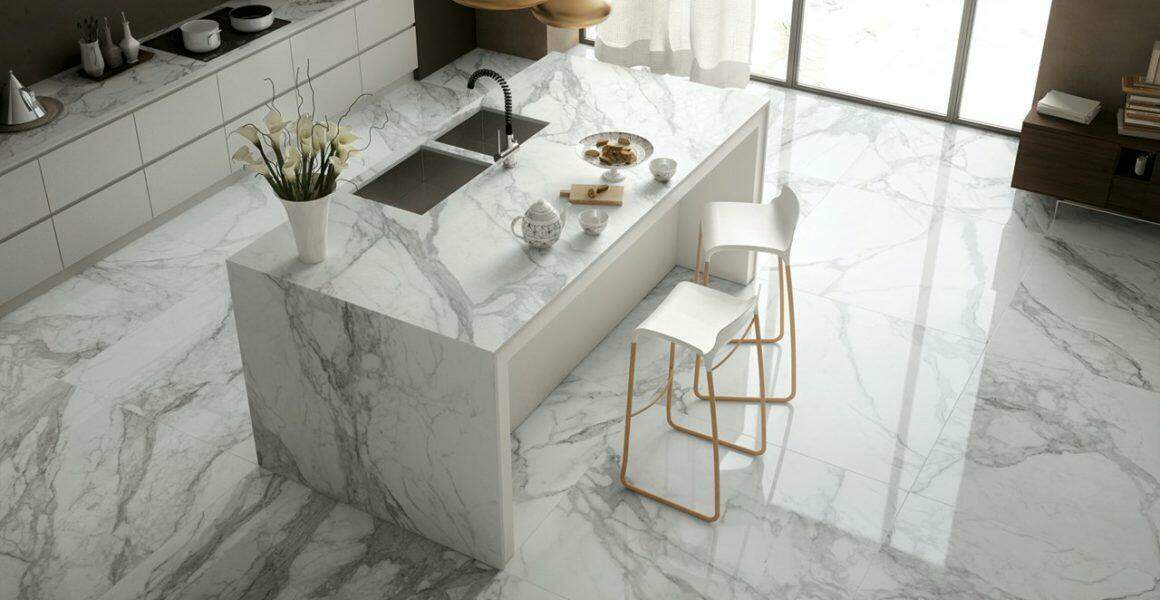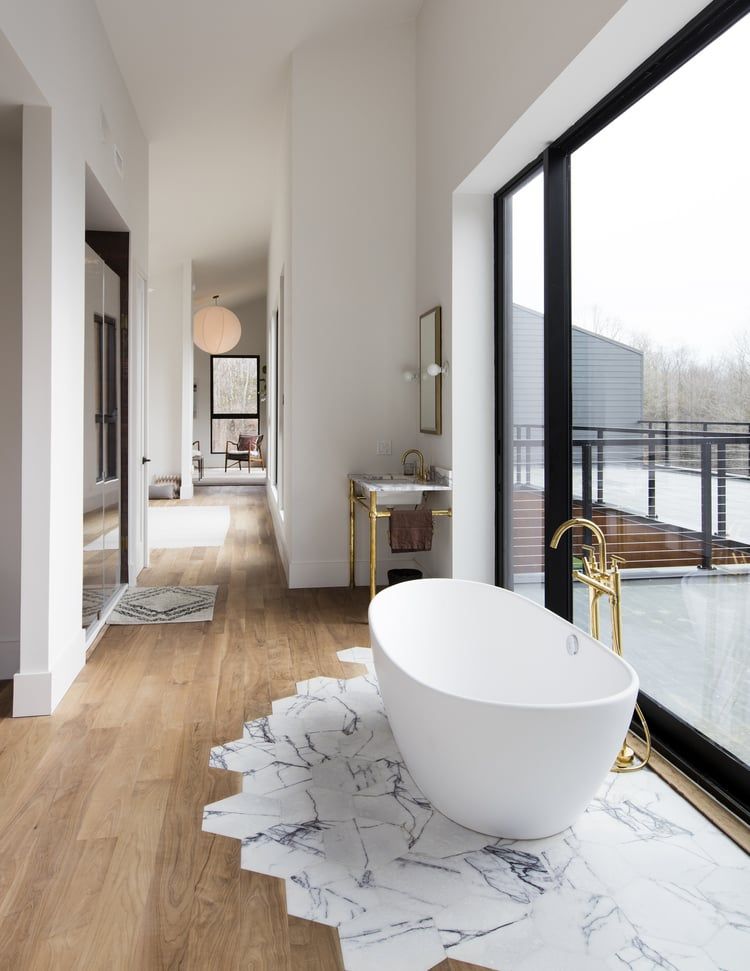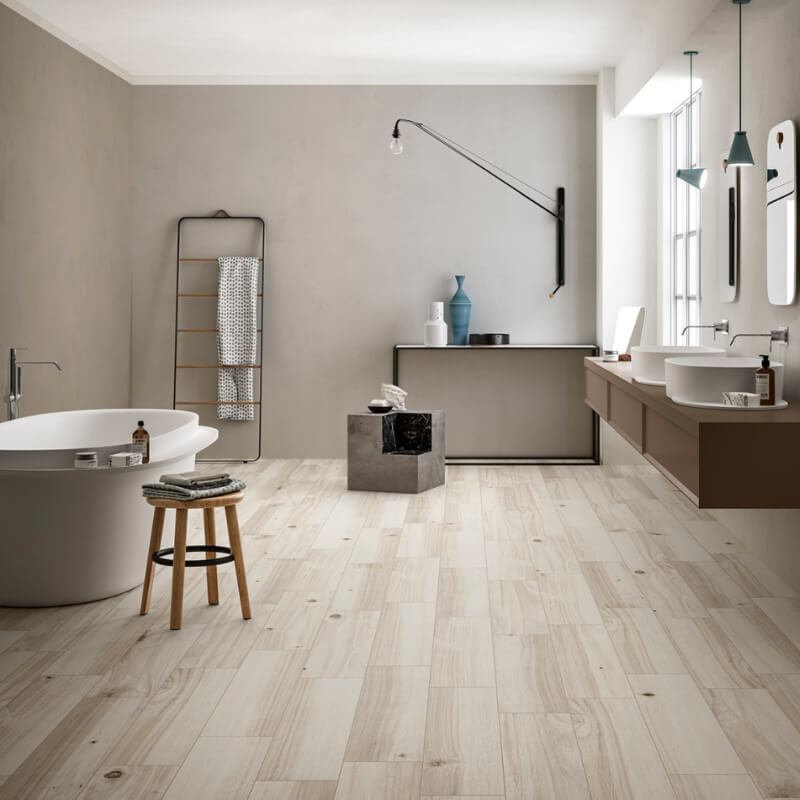Modern Tile Flooring: Trends and Styles
Tile flooring has come a long way from traditional ceramic squares. Today, modern tile flooring offers endless possibilities for design, allowing homeowners to experiment with various textures, patterns, and colors. Whether you’re looking for something bold or minimalistic, there’s a tile option to match your style.
- Sleek and Minimalist Designs: One of the top trends in modern tile flooring is the move toward minimalist aesthetics. Clean lines, neutral colors, and large, smooth tiles are key features that create a seamless, clutter-free look in any space. Think large-format tiles in shades of gray, white, or beige.
- Textured Surfaces: Textured tiles are also making waves in the world of modern flooring. From stone-like finishes to subtle ridges and patterns, textured tiles add dimension to floors and are especially popular in spaces like bathrooms and kitchens, where a bit of grip is useful.
- Metallic and Glossy Finishes: For those who want to add a touch of glamour, metallic and glossy tiles offer an eye-catching solution. Reflective surfaces can make a room feel brighter and more spacious, adding a sleek, contemporary vibe to any area.
- Natural Stone Inspiration: Modern tile designs are increasingly being inspired by natural stone, from marble to slate. These tiles capture the luxurious and timeless feel of natural stone but with the durability and easy maintenance that tile provides.
- Patterns and Shapes: From hexagons to diamonds, tiles are no longer confined to squares or rectangles. Unique shapes and intricate patterns are giving homeowners the chance to create flooring that acts as a statement piece in their homes.
- Color Trends: Neutral shades remain popular, but modern tile flooring is also embracing bold colors like navy, deep greens, and even black. These darker tones add sophistication and drama, especially when paired with contrasting furniture and décor.

Bold Geometric Patterns: Creating Visual Impact with Tile
If you’re someone who loves to make a statement, bold geometric patterns are a fantastic option for your flooring. These striking designs can completely transform a room, making your floor the focal point of your space.
Hexagons and Honeycomb Designs: Hexagonal tiles are one of the most popular choices when it comes to modern geometric flooring. Their unique shape adds visual interest without being overwhelming. For a contemporary look, try alternating between different shades of the same color family for a subtle ombre effect.
Chevron and Herringbone Patterns: Chevron and herringbone patterns are classic designs that are making a strong comeback. These patterns are often associated with wooden floors, but they’ve made their way into tile designs too. Pairing bold colors in a chevron pattern can create an eye-catching, stylish floor.
Diamond and Triangle Tiles: Diamond and triangle-shaped tiles allow for even more creativity. By combining contrasting colors, you can achieve a three-dimensional effect that adds depth and texture to the room. These patterns are perfect for adding drama to entryways or living spaces.
Mixing Shapes and Sizes: One exciting trend is mixing different geometric shapes and sizes to create a custom, dynamic look. You can combine large hexagons with smaller squares or mix triangle tiles with traditional rectangles for an eclectic yet cohesive design.
Monochrome Geometrics: If you prefer something more understated but still bold, monochrome geometric patterns are a great option. Black and white geometric tiles are timeless and can suit both modern and vintage-inspired homes, giving the room a chic, classic look.
Layering Patterns for a Dynamic Look: Another modern take on geometric patterns is layering. This involves using a variety of different tiles and patterns to create a complex, textured effect. For instance, you could pair bold geometric floor tiles with a more subtle wall tile to achieve a cohesive yet multi-layered design.
Wood-Look Tiles: A Perfect Blend of Warmth and Durability
For many homeowners, wood flooring is a dream—but it comes with its downsides, like moisture sensitivity and the need for regular maintenance. That’s where wood-look tiles come in. They offer the beauty of wood combined with the durability and water resistance of tile.
Why Choose Wood-Look Tiles?: Wood-look tiles are an ideal option for those who love the warmth and natural beauty of wood but need something more practical for high-moisture areas like kitchens or bathrooms. They mimic the appearance of hardwood planks but are made of ceramic or porcelain.
Durability in High-Traffic Areas: Wood-look tiles are much more durable than actual wood, especially in areas with heavy foot traffic or where spills are common. Unlike real wood, they won’t warp, scratch easily, or need refinishing over time, making them perfect for homes with pets and kids.
Wide Variety of Styles: Modern wood-look tiles come in a range of colors and grain patterns, from light, Scandinavian-inspired blonde woods to deep, rich mahogany tones. Some tiles even mimic reclaimed wood, giving your floors a rustic, weathered look.
Seamless Transitions: One of the best features of wood-look tiles is their ability to seamlessly transition between indoor and outdoor spaces. Since they’re weather-resistant, you can use them on patios or outdoor decks to extend your living space, all while maintaining a cohesive design.
Underfloor Heating Compatibility: Wood-look tiles are an excellent choice if you’re considering underfloor heating. Real wood can crack or warp with temperature changes, but tiles handle the heat well, making them a great match for this cozy feature.
Eco-Friendly and Low-Maintenance: While traditional hardwood floors require constant care and can contribute to deforestation, wood-look tiles are a more eco-conscious choice. Made from sustainable materials and requiring less maintenance, they offer the beauty of wood without the environmental impact.
Large-Format Tiles: Sleek and Seamless Flooring Solutions
Large-format tiles are all the rage in modern design, and for good reason. These oversized tiles create a sleek, seamless look, making them ideal for contemporary homes that value simplicity and open spaces.
What Are Large-Format Tiles?: Large-format tiles are typically defined as tiles that are at least 12×24 inches in size. Some can be even larger, which minimizes the number of grout lines and creates a smooth, uninterrupted surface. This is particularly beneficial in modern spaces where clean, minimal designs are preferred.
A Sleek, Modern Aesthetic: Because large-format tiles reduce the number of grout lines, they create a seamless, expansive look. This makes rooms appear bigger and more open, which is perfect for modern homes that prioritize a sense of flow and spaciousness.
Perfect for Small Spaces: Surprisingly, large tiles work well even in smaller rooms. Fewer grout lines make the floor appear less busy, helping to visually expand the space. If you have a small bathroom or hallway, consider using large-format tiles to make the area feel more expansive.
Matte vs. Glossy Finishes: Large-format tiles are available in a variety of finishes. Matte finishes are great for creating a subtle, sophisticated look, while glossy tiles reflect light and can make a room feel brighter. Choosing the right finish depends on the ambiance you want to create.
Maintenance Made Easy: Fewer grout lines also mean less maintenance. Grout can be a magnet for dirt and grime, so minimizing grout lines reduces the areas where dirt can accumulate. This makes large-format tiles an excellent choice for kitchens, bathrooms, or other high-traffic areas.
Versatility in Design: Large-format tiles aren’t just for floors. They can be used on walls as well, offering a consistent, sleek design that ties together an entire room. Whether you’re going for a spa-like bathroom or a minimalist kitchen, large-format tiles are an excellent solution.
Mixing and Matching Tile Textures for a Unique Look
Mixing and matching different tile textures is a fun way to create a unique, personalized look for your floors. Whether you’re combining smooth, glossy tiles with rough, stone-like surfaces or mixing different finishes, this approach adds dimension and character to any space.
Why Mix Tile Textures?: Combining different textures can add visual interest and depth to your floors, breaking up the monotony of a single finish. For example, pairing matte tiles with glossy tiles can create a dynamic contrast that draws the eye.
Contrasting Finishes: A popular way to mix textures is by contrasting matte and glossy finishes. For instance, in a bathroom, you could use matte tiles for the floor and glossy tiles for the walls to create a subtle yet sophisticated contrast.
Combining Natural and Polished Tiles: Another option is mixing natural stone tiles with polished tiles. This creates a balanced look that blends the organic, rugged feel of stone with the sleekness of polished surfaces, making it ideal for living spaces that need both comfort and style.
Layering Different Sizes: Mixing tile textures doesn’t have to stop at finishes—you can also play with tile sizes. Combining large, smooth tiles with smaller, textured ones can create a layered effect, adding complexity and intrigue to your flooring.
Tonal Variations for a Cohesive Look: If you prefer a more subtle design, try mixing tiles of different textures but within the same color family. This approach maintains a cohesive look while still adding layers of texture that prevent the floor from looking flat or boring.
Incorporating Textures into Patterns: For an even bolder approach, consider using textured tiles in geometric or mosaic patterns. This allows you to experiment with both shape and texture, resulting in a truly one-of-a-kind floor design.
Monochrome Tiles: Minimalist and Chic Flooring Designs
Monochrome tiles are a favorite in modern design for their simplicity and elegance. Whether you go for all-black, all-white, or a combination of the two, monochrome tiles create a sleek, timeless look that works well in a variety of settings.
The Beauty of Simplicity: Monochrome flooring designs are all about keeping things simple. By focusing on a single color or a minimal palette, you can create a clean, streamlined look that feels fresh and modern. These designs are perfect for those who want a minimalist aesthetic without sacrificing style.
Black-and-White Contrast: One of the most classic monochrome combinations is black and white. This contrast creates a bold, graphic look that never goes out of style. Whether you opt for a checkerboard pattern or mix and match different tile sizes, black-and-white tiles can add drama and sophistication to any room.
All-White Elegance: All-white tile floors are another popular choice, especially for those looking to brighten up a space. White tiles reflect light, making rooms feel larger and more open. Pairing them with light-colored walls and furniture can create an airy, serene environment.
All-Black Boldness: On the other end of the spectrum, all-black tile floors make a strong statement. Black tiles are sleek, modern, and surprisingly versatile. They can add a sense of luxury and drama to a room, especially when paired with contrasting light-colored furniture and décor.
Gray Tones for a Softer Look: If black and white feel too harsh, gray monochrome tiles offer a softer alternative. Shades of gray can create a calming, neutral backdrop that works well in both modern and traditional homes. Gray tiles are also great for hiding dirt and wear, making them a practical option for busy households.
Matte vs. Glossy Finishes: The finish you choose for your monochrome tiles can have a big impact on the overall look of the room. Matte finishes create a soft, understated feel, while glossy tiles add shine and reflect light, making the space feel more dynamic.
Eco-Friendly Tile Options for a Modern Sustainable Home
As more homeowners become conscious of their environmental impact, eco-friendly tile options are gaining popularity. From recycled materials to sustainably sourced tiles, there are many ways to make your flooring both stylish and sustainable.
Recycled Glass Tiles: Recycled glass tiles are a beautiful and eco-friendly option for modern homes. Made from post-consumer or post-industrial glass, these tiles come in a variety of colors and finishes, offering a sleek, modern look while reducing landfill waste.
Bamboo Tiles: Bamboo is one of the most sustainable materials available for flooring. Bamboo tiles combine the strength and durability of tile with the eco-friendliness of bamboo, making them a perfect option for those looking to minimize their environmental footprint.
Cork Tiles: Cork is another sustainable material that has made its way into modern flooring. Cork tiles are made from the bark of the cork oak tree, which can be harvested without harming the tree. Cork tiles are soft, comfortable underfoot, and naturally resistant to mold and mildew.
Reclaimed Wood Tiles: For those who love the look of wood but want to stay environmentally friendly, reclaimed wood tiles are a great option. These tiles are made from recycled wood, giving new life to materials that would otherwise go to waste. They add warmth and character to any space.
Low-VOC and Non-Toxic Tiles: Eco-friendly tiles aren’t just about the materials—they’re also about the production process. Look for tiles that are low in volatile organic compounds (VOCs) and made without toxic chemicals. These options are better for both the environment and your indoor air quality.
Sustainable Manufacturing Practices: Many tile manufacturers are adopting more sustainable practices, such as using renewable energy, reducing water consumption, and recycling production waste. By choosing tiles from companies with eco-friendly manufacturing processes, you can further reduce your carbon footprint while still achieving a modern, stylish look.
Porcelain tile flooring – modern and durable home flooring ideas
Tile Floor Design Ideas
Tile Wood-look Flooring Ideas
Basement Flooring Ideas (Best Design Options) – Designing Idea
Related Posts:









